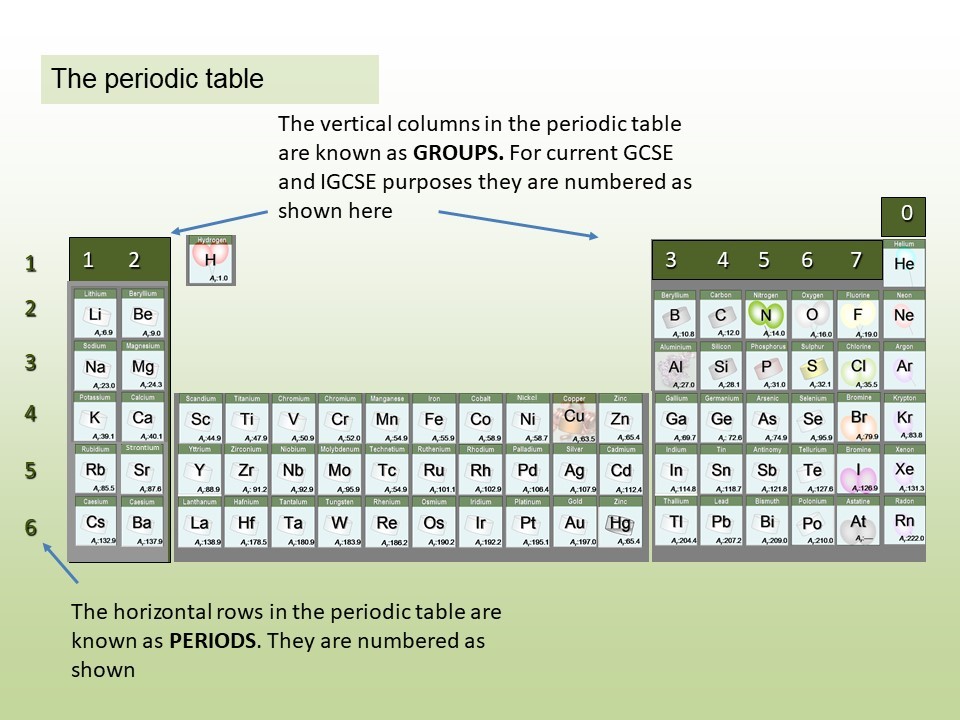1.18 - 1.24 The periodic table
1.18 Organising the Elements
Students should:
1.18 understand how elements are arranged in the Periodic Table:
- in order of atomic number
- in groups and periods
1.19 understand how to deduce the electronic configurations of the first 20 elements from their positions in the Periodic Table
The modern periodic table provides a list of all the known elements categorized in increasing order of increasing atomic number.
Each row across the periodic table is known as a period.
Each column is known as a group.
1.19 Deducing electron configurations
A carbon atom has 6 protons and therefore 6 electrons. The electrons are arranged in two shells; 2 electrons in the first shell and 4 electrons in the second shell. The electron configuration of a carbon atom can be therefore represented as: 2, 4
The electrons in an atom arrange themselves in shells ( or levels) around the nucleus. The electrons fill the innermost shells first . Each shell can contain a maximum number of electrons.
This model works well for explaining the properties of the first 20 elements in the periodic table - a more complex model is needed to explain the structure of atoms above atomic number 20.
1.19 Activity 1. Looking for patterns
Filling up nicely.
Chlorine has an atomic number of 17. This means that the atoms have 17 protons. Because atoms have no overall charge the number of electrons must also be 17. These are arranged as follows:
Starting with the innermost shell .
2 electrons ( maximum for shell 1)
8 electrons ( maximum for shell 2)
7 electrons left over = (17 - (8 + 2))
Question.
The atomic number of Potassium is 19 and that of Calcium is 20. What is the electron configuration for each atom?
Answers: Potassium K, Calcium Ca
1.20 - 1.22 Activity 2. Periodic variations
Students should:
1.20 understand how to use electrical conductivity and the acid-base character of oxides to classify elements as metals or non-metals
1.21 identify an element as a metal or a non-metal according to its position in the Periodic Table
1.22 understand how the electronic configuration of a main group element is related to its position in the Periodic Table
Good conductors?
Study the presentation to investigate and answer the following questions:
- What can you say about the connection between the number of electrons in the outer shell of the atoms and the group number shown?
- What can you say about the number of occupied electron shells and the period number.
- What can you say about the electron configuration of the noble gases?
- Where on the periodic table are the metals found?
- What can you say about the electrical conductivity of the metals compared with that of the non- metals?
The period number tells us the number of occupied electron shells in a given atom.
The group number shows the number of electrons in the outermost shell of the atom.
The atoms of the elements in group 8 have full outer shells of electrons
The metals can be found to the left and bottom of the periodic table.
The metals all conduct an electric current. The semi metals are semiconductors. The non-metals do not conduct an electric current.
Acid or base?
This video animation shows how the acid/base properties of the oxides varies across the periodic table. The pattern is not perfect partly because many non-metals can form more than one oxide and also because their solubility varies. However a general trend can be seen.
Stop the video after 21 seconds and try to predict what the trend will be. Test your prediction by watching the rest of the video.
What general conclusion can you make about the acidity or alkalinity of the oxides of :
- Metals?
- Non-Metals?
- Semi-metals?
The oxides of metals are generally alkaline ( basic) . The oxides of non metals are generally acidic.
The oxides of the semi-metal elements (e.g Si, Ge) tend to be "neutral" and not very soluble in water. These oxides will however dissolve in both acids and in alkalis. Such oxides are known as amphoteric oxides.
1.23 Family resemblances
Students should:
1.23 understand why elements in the same group of the Periodic Table have similar chemical properties
1.24 understand why the noble gases (Group 0) do not readily react
Looking at the electron arrangements of the atoms in groups 1, 2 and 3 you can see that the atoms of group 1 elements have 1 electron in their outermost shell, group 2 elements all have 2 electrons and group 3 elements 3. This carries on in groups 4,5,6,7.
This similarity of electron configuration within a given group of elements explains why the elements in a group behave in similar ways; they have similar physical and chemical properties.
For example: lithium Li , sodium Na, and potassium K :
- all react violently with water.
- are all soft low density metals
- combine with chlorine atoms in a 1:1 ratio
- form oxides which dissolve to give an alkaline solution
1.24. Activity 4. A Noble family
The chemical behaviour of a element is partly determined by the number of electrons in the outer shell.
In the noble gases or group 0 the outermost shell of the atoms contains 8 electrons (2 in case of Helium) which is a stable state configuration.
Hence, the noble gases are chemically unreactive or inert.
noble, inert, 8 or 0?
In the shortened periodic table, the group number is the same as the number of outer shell electrons in the atoms of that group. This is not true for the noble gases. Helium only has 2 electrons in its outer shell, while the others all have 8 . Because of this, the group number was changed to 0 .
Originally the group was known as the inert gases as it was thought that they would not react with anything. However in 1962 a chemist called Bartlett made a compound from Xenon. The preferred name for the group is now the noble gases.
-
Why is argon used to fill light bulbs ? Open or Close
 Argon gas is used to surround the filament in incandescent light bulbs. Argon is inert and therefore does not react with the white hot filament. If air was used the filament would quickly react with the oxygen in it and the lamp would blow.
Argon gas is used to surround the filament in incandescent light bulbs. Argon is inert and therefore does not react with the white hot filament. If air was used the filament would quickly react with the oxygen in it and the lamp would blow. -
Why is helium rather than hydrogen preferred for use in airships? Open or Close
Helium and hydrogen are both less dense than air and so can both be used to provide the uplift for a airship. However, hydrogen is very flammable and was the cause of the Hindenburg disaster in 1937.
Helium is inert and is therefore quite safe to use in gas balloons and airships.
-
What does the word inert mean ? Open or Close
Inert is used to refer to a substance that does not react with others. The noble gases are all fairly inert due to the full outer shell of electrons.
Nitrogen gas is quite inert due to its triple bond. The precious metals such as gold, platinum, and silver can also be describes as inert. The noble gases are thought to have been named after these noble metals.
-
Why is the preferred name for this group the "noble gases" Open or Close
For a long time, many people believed the noble gases to be completely nonreactive and unable to form chemical compounds. Although these elements don't form compounds readily, examples of molecules containing xenon, krypton, and radon have been found. At high pressure, even helium, neon, and argon participate in chemical reactions. The name "noble" is preferable to inert since strictly speaking they are not completely inert.
-
Did you know? Open or Close
- The first noble gas to be discovered was argon.
- Argon glows violet in a gas discharge tube. It is the gas found in plasma balls.
- Argon gas is prepared by fractionating liquid air.
- The Earth's atmosphere contains 0.94% argon.
- Mars' atmosphere contains 1.6% Argon
- The thin atmosphere of the planet Mercury is about 70% argon.










